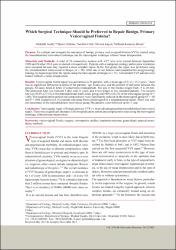Which Surgical Technique Should be Preferred to Repair Benign, Primary Vesicovaginal Fistulas?
Abstract
Purpose: To evaluate and compare the outcomes of benign, primary vesicovaginal fistulas (VVFs) treated using the transabdominal transvesical technique and the transvaginal technique without tissue interposition. Materials and Methods: A total of 53 consecutive women with VVF who were treated between September 1999 and October 2014 were evaluated retrospectively. Patients with a malignant etiology and/or prior irradiation were excluded because they required a more complex repair. In the first group, the repair was performed using the transabdominal transvesical technique (n = 28). After one of our fellows had completed his urogynecology training, he began to perform the repairs using the transvaginal technique (n = 25). All included VVF patients were treated without a tissue interposition. Results: Vesicovaginal fistula repair was performed in 53 patients, with a mean age of 41.4 +/- 15.2 years. There was no significant difference in terms of the patients' age, fistula size, and the number of deliveries between the groups. All cases failed in terms of conservative management. The size of the fistulas ranged from 15 to 20 mm. The admission time was between 3 days and 21 years, and it was longer in less educated patients. The success rate was 96.4% (27/28) in the transabdominal transvesical group and 100% (25/25) in the transvaginal group (P = 1.00). The hospitalization period and complications were significantly reduced in the transvaginal group (P = .00 and P = .004, respectively). No patients converted from a transvaginal to a transabdominal repair. There was only one recurrence in the transabdominal transvesical group. The patients were followed up for 1 year. Conclusion: Transvaginal repair of benign, primary VVFs is more advantageous than transabdominal transvesical repair. There was a significant decrease in the hospitalization period and complications rates using the transvaginal technique without tissue interposition.


















